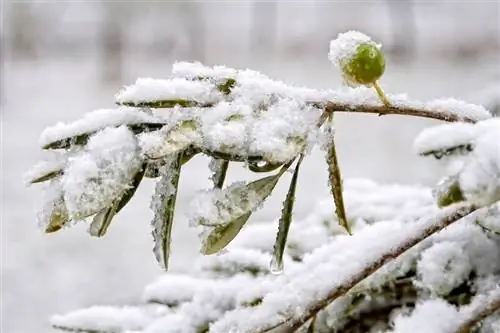- Author admin [email protected].
- Public 2023-12-16 16:46.
- Last modified 2025-06-01 06:02.
The exotic fuchsias mostly come from the South American Andes, where they grow on the edge of the rainforests at altitudes of up to 3000 meters. Some species can also be found in Haiti or in Australia and New Zealand - but no matter where your fuchsia species comes from, it is not designed for Central European winters. Frost in particular causes problems for the sensitive plants.

How do you protect fuchsias from frost?
Fuchsias are not frost-resistant and are sensitive to low temperatures. To protect them in winter, they should be moved to a frost-free room with cool temperatures (8-10 degrees Celsius) and taken indoors in spring when late frost threatens.
Fuchsias are not frost-resistant
Fuchsias have no natural frost protection, so their leaves split open and die at temperatures below zero degrees Celsius (i.e. the point at which water freezes). Depending on the species and variety, even a short-term, not too deep night frost can be fatal for the plant if it is accompanied by wind and low humidity. Dry cold is dangerous for fuchsias not only for young plants, but also for old, woody specimens.
Hardy fuchsias
The fuchsias offered in this country as hardy are also not really frost-resistant and are only winter-hardy in mild regions. With these plants - as with many perennials - the above-ground parts of the plant freeze off, but usually sprout again reliably in spring. Hardy fuchsias are not suitable for container cultivation, but should always be provided with adequate winter protection when overwintering.
Frost protection for fuchsias - How are fuchsias properly overwintered?
Fuchsias should only overwinter frost-free, but in cool, cold house conditions. The temperatures must be kept constant at around eight to ten degrees Celsius; But in principle it doesn't matter whether you overwinter your fuchsias in a light or dark color. The plants shed their leaves in autumn and can therefore overwinter in the dark cellar or attic. Despite the plants' sensitivity, the rule is to clear fuchsias as late as necessary and clear them out again as early as possible.
Late frost in spring is particularly dangerous
Basically, if the weather permits, you can put the fuchsias outdoors in early to mid-April, although you must pay attention to potential night frosts. If a frost in late autumn is usually not particularly dramatic - especially if it is accompanied by moisture or even snow - a late frost in spring will quickly kill the plant. So keep a close eye on the weather forecasts and put the fuchsias indoors overnight.
Tip
You can spray hardy fuchsias all over with a fine mist of water when frost is imminent using a spray bottle (€6.00 on Amazon). This quickly forms a layer of ice that protects the plant from frost.






